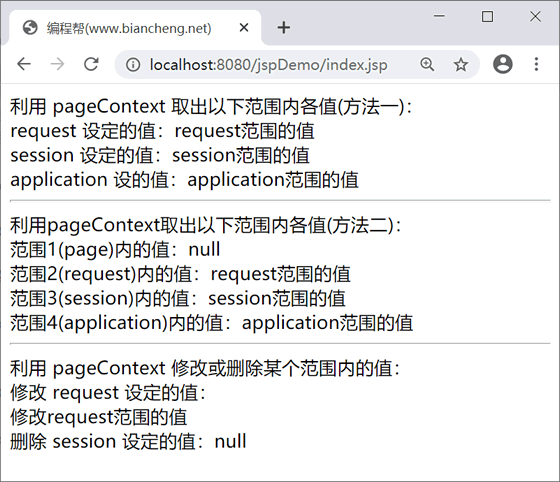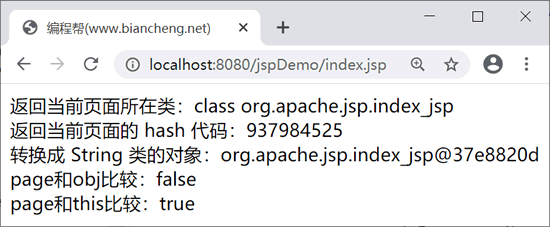您好,登錄后才能下訂單哦!
您好,登錄后才能下訂單哦!
這篇文章主要講解了“Java中JSP的pageContext對象和page對象怎么使用”,文中的講解內容簡單清晰,易于學習與理解,下面請大家跟著小編的思路慢慢深入,一起來研究和學習“Java中JSP的pageContext對象和page對象怎么使用”吧!
pageContext 是 javax.servlet.jsp.PageContext 的實例對象。
pageContext 對象表示整個 JSP 頁面,可以獲取或刪除以下對象的任意屬性:
page
request
session
application
pageContext 常用的方法如下:
Object findAttribute (String AttributeName):按 page、request、session、application 的順序查找指定的屬性,并返回對應的屬性值。如果沒有相應的屬性,則返回 NULL
Object getAttribute (String AttributeName, int Scope):在指定范圍內獲取屬性值。與 findAttribute 不同的是,getAttribute 需要指定查找范圍
void removeAttribute(String AttributeName, int Scope):在指定范圍內刪除某屬性
void setAttribute(String AttributeName, Object AttributeValue, int Scope):在指定范圍內設置屬性和屬性值
Exception getException():返回當前頁的 Exception 對象
ServletRequest getRequest():返回當前頁的 request 對象
ServletResponse getResponse():返回當前頁的 response 對象
ServletConfig getServletConfig():返回當前頁的 ServletConfig 對象
HttpSession getSession():返回當前頁的 session 對象
Object getPage():返回當前頁的 page 對象
ServletContext getServletContext():返回當前頁的 application 對象
使用 PageContext 對象取得不同范圍的屬性值。index.jsp 代碼如下:
<%@ page language="java" contentType="text/html; charset=UTF-8"
pageEncoding="UTF-8"%>
<!DOCTYPE html>
<html>
<head>
</head>
<body>
<%
request.setAttribute("info", "request范圍的值");
session.setAttribute("info", "session范圍的值");
application.setAttribute("info", "application范圍的值");
%>
利用 pageContext 取出以下范圍內各值(方法一):
<br> request 設定的值:<%=pageContext.getRequest().getAttribute("info")%>
<br> session 設定的值:<%=pageContext.getSession().getAttribute("info")%>
<br> application 設的值:<%=pageContext.getServletContext().getAttribute("info")%>
<hr>
利用pageContext取出以下范圍內各值(方法二):
<br> 范圍1(page)內的值:<%=pageContext.getAttribute("info", 1)%>
<br> 范圍2(request)內的值:<%=pageContext.getAttribute("info", 2)%>
<br> 范圍3(session)內的值:<%=pageContext.getAttribute("info", 3)%>
<br> 范圍4(application)內的值:<%=pageContext.getAttribute("info", 4)%>
<hr>
利用 pageContext 修改或刪除某個范圍內的值:
<%
pageContext.setAttribute("info", "修改request范圍的值", 2);
%>
<br> 修改 request 設定的值:
<br>
<%=pageContext.getRequest().getAttribute("info")%>
<br>
<%
pageContext.removeAttribute("info");
%>
刪除 session 設定的值:<%=session.getAttribute("info")%>
</body>
</html>運行結果如下:

index.jsp運行結果
JSP page 的實質是 java.lang.Object 對象,相當于 Java 中的 this 關鍵字。
page 對象是指當前的 JSP 頁面本身,在實際開發中并不常用。
page 對象的常用方法如下:
class getClass():返回當前頁面所在類
int hashCode():返回當前頁面的 hash 代碼
String toString():將當前頁面所在類轉換成字符串
boolean equals(Object obj):比較對象和指定的對象是否相等
void copy (Object obj):把對象復制到指定的對象中
Object clone():復制對象
下面通過一個簡單的例子來演示 page 中的方法。
index.jsp 代碼如下:
<%@ page language="java" contentType="text/html; charset=UTF-8" pageEncoding="UTF-8"%> <!DOCTYPE html> <html> <head> </head> <body> <% Object obj; obj = null; %> 返回當前頁面所在類:<%=page.getClass()%> <br> 返回當前頁面的 hash 代碼:<%=page.hashCode()%> <br> 轉換成 String 類的對象:<%=page.toString()%> <br> page和obj比較:<%=page.equals(obj)%> <br> page和this比較:<%=page.equals(this)%> </body> </html>
運行結果如下:

感謝各位的閱讀,以上就是“Java中JSP的pageContext對象和page對象怎么使用”的內容了,經過本文的學習后,相信大家對Java中JSP的pageContext對象和page對象怎么使用這一問題有了更深刻的體會,具體使用情況還需要大家實踐驗證。這里是億速云,小編將為大家推送更多相關知識點的文章,歡迎關注!
免責聲明:本站發布的內容(圖片、視頻和文字)以原創、轉載和分享為主,文章觀點不代表本網站立場,如果涉及侵權請聯系站長郵箱:is@yisu.com進行舉報,并提供相關證據,一經查實,將立刻刪除涉嫌侵權內容。